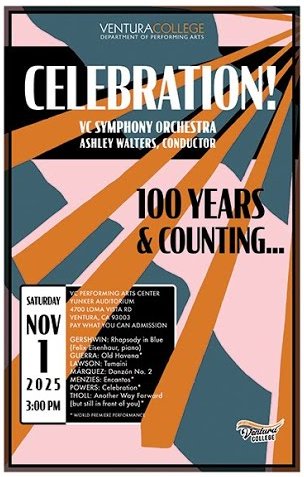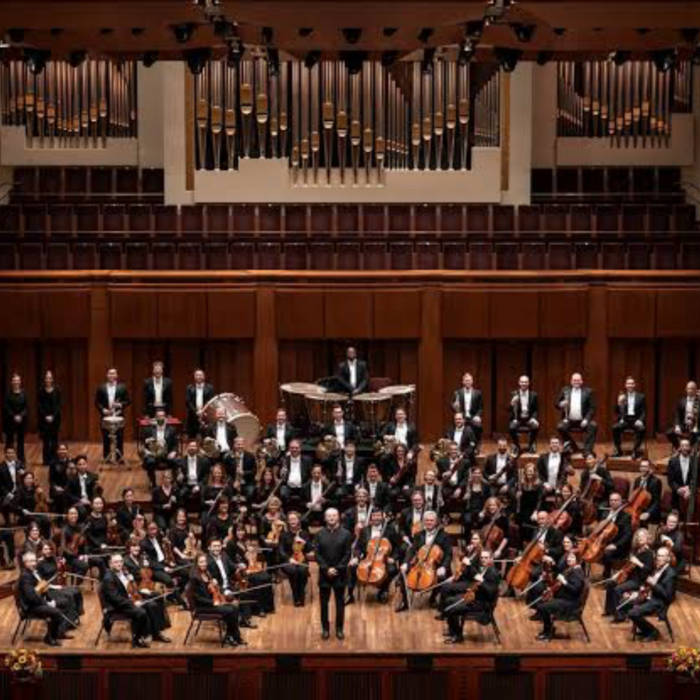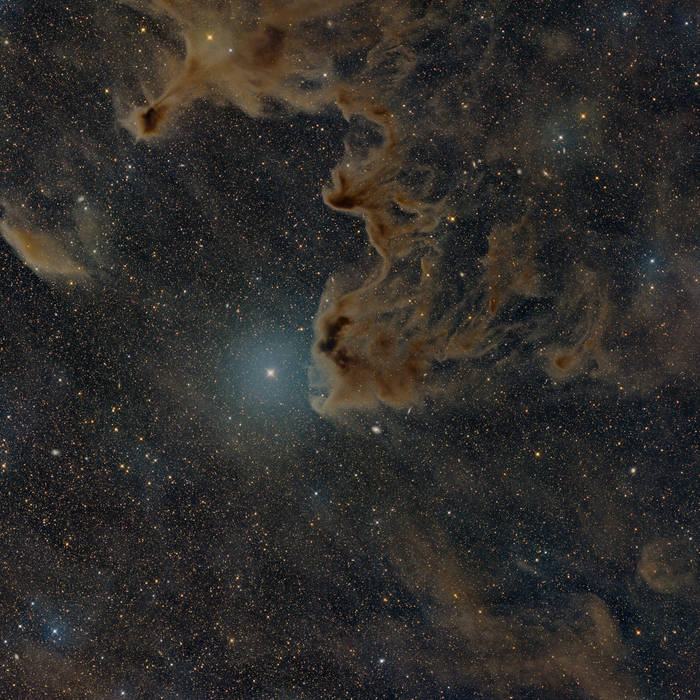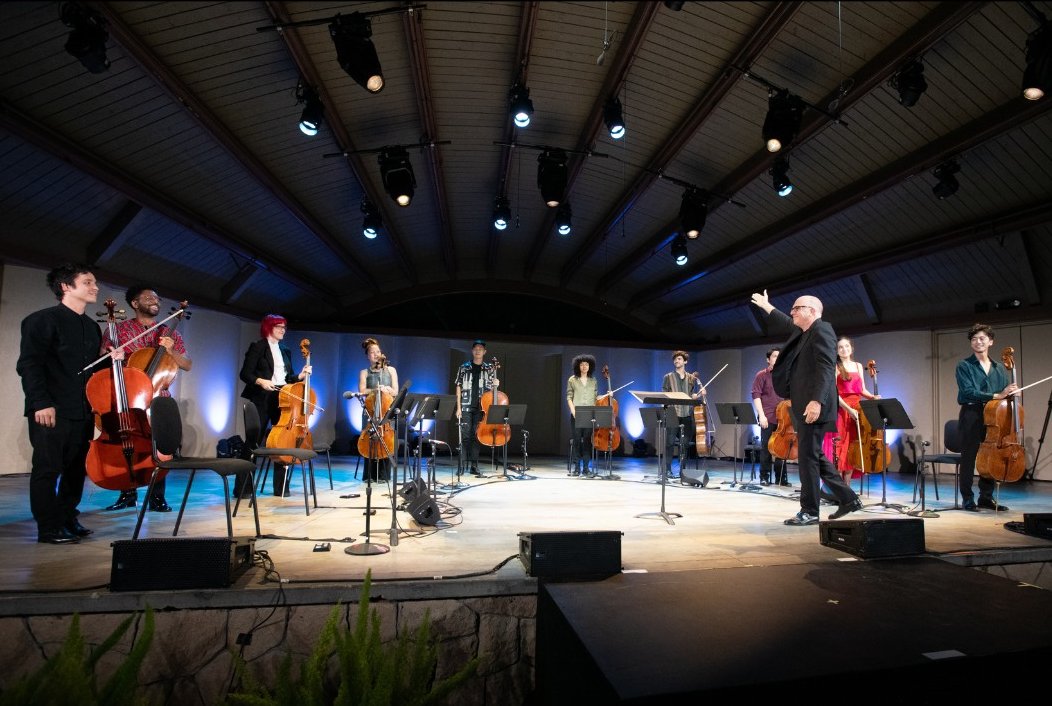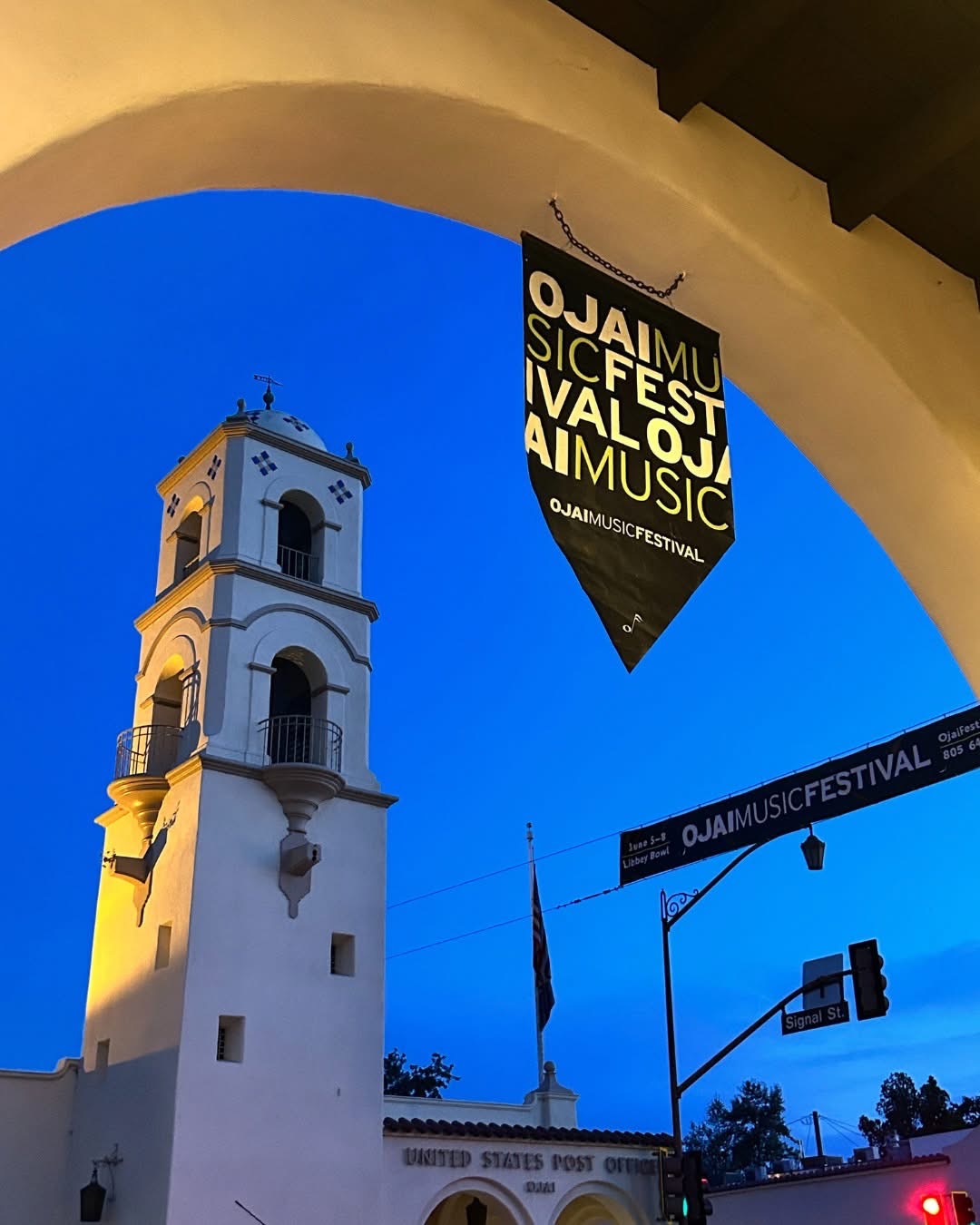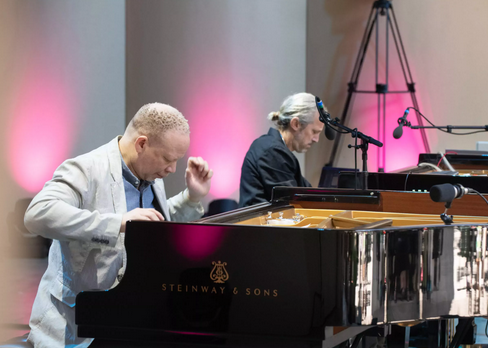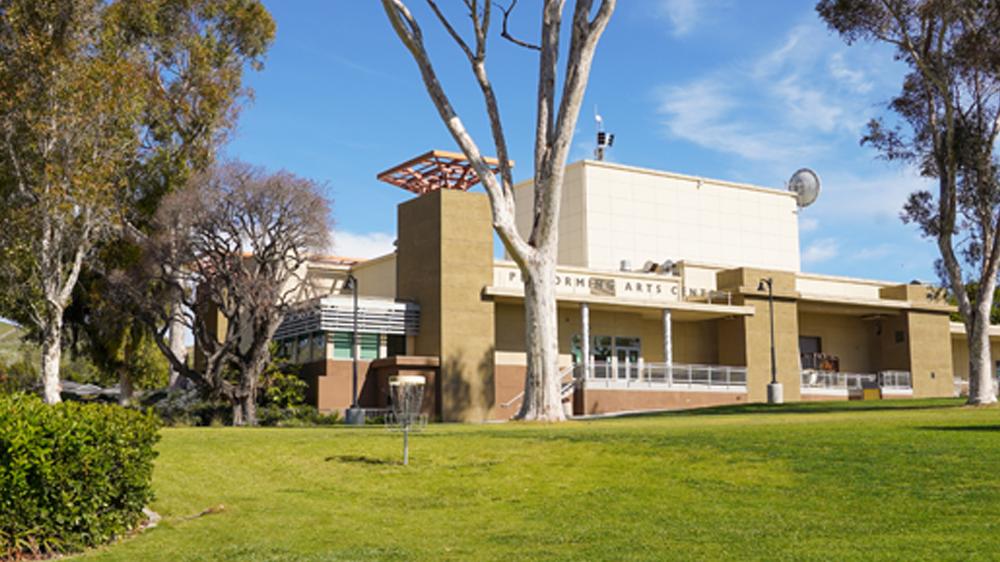
On November 1, 2025, the Ventura College Symphony Orchestra presented “Celebration!”, a concert of contemporary music marking the Centennial of the founding of the school. Yunker Auditorium filled with a capacity crowd and the College Symphony – some 70 players strong – sprawled across every inch of the concert stage. Over two hours of music was programmed, featuring four world premiers and including compositions by past and present music faculty. Highlight of the concert was the premiere of Encantos, a piece by New Zealand composer Mark Menzies commissioned by Conductor Ashley Walters. Appropriately, the concert concluded with George Gershwin’s popular Rhapsody in Blue, a work that, like Ventura College, premiered 100 years ago this year. “Celebration!” was an ambitious program and a milestone in the evolution of the Ventura College Music program.
First up was Encantos (2025). Mark Menzies, the composer, is a virtuoso violinist, chamber musician, pianist, conductor and a strong advocate for contemporary music. He has appeared at the Ojai Music Festival and performed throughout the US, Europe, South America, Australia and Japan. Menzies is presently Professor of Music at the University of Canterbury in Christchurch New Zealand. Starting in 1999, Menzies was on the faculty at Cal Arts for some 17 years. While there, he founded the Formalist Quartet, whose members included Ashley Walters and Andrew Tholl, now both music faculty at Ventura College.
During his time at Cal Arts, Menzies had occasion to visit the Ventura College music department. In the program notes he writes: “…when I drove for the very first time to Ventura down the 126 (and I had only begun to drive), all the orange blossoms were in full bloom. It was an incredible feeling…” Encantos, the opening work on the concert program, reflects the joy Menzies felt coming here to Ventura. The piece was written in tribute to Ventura College on its 100th anniversary.
Encantos begins with slow string tones accompanied by solitary notes from a harp. More strings join in underneath with a lush wash of warm sound. Percussion is heard, yet the overall effect is quietly soothing and exotic. The large orchestra successfully maintained careful control over the dynamics and the result was an almost pastoral feeling. As the piece proceeded, a crescendo in the strings ended in a sharp brass sforzando passage signaling new drama and suspense. At that moment, a series of mechanical clickers were heard rising from the audience accompanied by random clapping from the members of the orchestra. The overall effect was like the splashing of raindrops in a heavy rainfall. This escalated into a violent storm with a series of loud and rapid phrases from the trombones and upper brass. The wild texture continued and culminated in a heavy wash of loud sounds that evoked a sudden California flash flood. The energy of this rose quickly to a peak, and ended in a sudden silence.
A skittering of quiet woodwinds followed – perhaps the calm after the storm. Solemn viola notes were heard along with a strong bass drum beat. As the full orchestra joined in, Encantos took on a more familiar and conventional form after the chaos of the preceding section. The strings coasted on, led by a bouncy clarinet solo. After a period of low throbbing in the basses, followed by a stout sforzando brass chord, Encantos faded to a quiet finish.
Encantos is challenging contemporary music and the orchestra navigated the complexities and nuances of the music in good order. The applause was sustained and sincere and the composer led in the cheering for the orchestra who gave a fine performance of his piece.
Another world premiere, Celebration for Orchestra (2025), by O. Powers, followed. Ollie Powers teaches composition and music technology at Ventura College and has studied with Pauline Oliveros. Celebration unfolds in layers so that each section of the orchestra plays a separate theme, in turn. As the piece proceeds, all the sections are combined together at the finish. It is just the sort of musical experiment of which Pauline Oliveros would approve, simple in concept and with surprising results.
The string section begins Celebration with a sharp opening chord followed by a strident pizzicato. The feeling here is purposeful and march-like, delivered with precise ensemble playing by the large string section. The brass entered next, with lush chords and strong passages accompanied by solid percussion. This was heard clearly in the audience, even with the brass section located in the very back of a crowded stage. Finally the woodwinds picked up their theme, a bright and bubbly passage full of movement and joy. The final section included all of the parts previously introduced, now in a great wave of sound. The combination of parts had a more conventional feel, but still surprising when finally played together. This formidable body of sound produced by the tutti orchestra was well balanced and did not overwhelm. Celebration was received with extended applause.
Next on the program was Another Way Forward (but still in front of you) (2025) by Andrew Tholl, still another world premiere. Tholl is faculty at Ventura College, teaching composition and violin. In his musical career he has worked closely with such notables as David Lang, Christian Wolff, Wadada Leo Smith and Harold Budd. Andrew was a member of the Formalist Quartet, the string ensemble that included Ashley Walters and Mark Menzies. Tholl’s compositions have been heard at the Walt Disney Concert Hall, Beyond Baroque and the Hammer Museum. His comments in the program notes describe Another Way Forward: “There are no parts, all players read from the same score and, at times, some players may be on one page of the score while other are playing off another.” Sounds like a recipe for chaos, but does it work?
Another Way Forward opens with a sumptuous chord in the brass, filled with unexpected and colorful harmonies. A light vibraphone trill above adds to the singular feeling. The triangle enters with its bright pinging sound as the low brass issue long, deep tones. The violins join in with more unusual harmonies and this adds a pleasing warmth to the overall emotional color. The brass section then replies with simple declarative chords, sometimes ominous and sometimes tense. All of this soon creates a great wash of sound driven forward by the strings while a quietly solemn violin/cello duo rises lightly above the texture.
At this point the woodwinds enter, playing in a separate tempo. This is not as jarring as might be expected, given the strong support underneath by the strings. The structure now is unconventional, yet very accessible, and the contrast in the textures and rhythms heard from the woodwinds are surprisingly effective. Soon, the brass enter with yet a different set of rhythms, creating a general wash of sound. This slowly resolves into more organized and conventional forms and there are some lovely harmonies now heard in the brass. The triangle keeps the beat as the various orchestra sections fade to the finish. Another Way Forward is a robustly unconventional piece yet it is not alienating to the ear. No doubt difficult music to play, the VC orchestra managed all the nuances with discipline to deliver Another Way Forward successfully.
Tumaini, by Robert Lawson followed. Lawson was past music faculty and a seminal force in shaping the VC music program in the 1980s. His influence is still being felt today. He was the Chair of the Performing Arts department at one point, and was instrumental in developing the Schwab Academy of Music. Lawson was also a composer and Tunmaini is one of his larger orchestral works.
“Tumaini” is a Swahili word meaning “Hope” and the piece opens with distant horn tones followed by a quiet entry in the string section. The contra basses carry the beat, supporting a gentle melody that emerges from the strings. The oboe tops this off with warm and relaxing solo. The generous sound of the large VC orchestra here is lush, controlled and pleasant. The sound and structure of the piece at this point is fairly conventional; engaging but not outsize. As the piece proceeds, a tutti crescendo slowly rises up in a moment of power, with a strong finishing phrase in the brass. The piece slowly winds down to a stately hymn-like passage in the strings. The music here is elegant and broad as if fades to the finish. Tumaini is both familiar and pleasing, suggesting the influence of the movie music of the time.
Danzón No. 2 (1994), by Arturo Márquez was next. The composer was a close friend of Robert Lawson, director of the orchestra in the 1980s. The program notes state that Danzón was inspired by “…the elegant Cuban dance form that found a vibrant second life in Mexico’s Veracruz region.” Danzón opens with a bright clarinet solo accompanied by piano and percussion. The bouncy syncopation and lively tempo deliver a wonderfully Latin flavor. The oboe joins in and then all the woodwinds take up the theme. The strings have the melody next, adding an accelerando that magnifies the rapid, dance-like feeling. The brass finally join in with strong sounds, assisted by loud percussion.
Danzón slows, although still in dance mode, it has now acquired a more refined and elegant sensibility. This is supported by sensuous passages in the strings and some strong counterpoint from the trombones. Soon, strident sounds from the percussion and brass herald a return to a more muscular texture, topped off by a dramatic trumpet solo. This escalates into a loud and raucous dynamic, joined by the strings, reaching a final powerful crescendo before settling back at the finish. The VC orchestra played all of this with the style and flash that the piece deserves. Danzón is an infectious and accessible piece that clearly pleased the audience.
After a short intermission, the world premiere of Old Havana – La Habana Viejo, by Yalil Guerra, was performed. Yalil Guerra is another VC faculty member teaching classical guitar and composition. He is from Cuba and Old Havana is a sentimental look at the “…colorful streets, colonial architecture, and the rhythmic pulse of everyday life in Havana, the piece captures the city’s unique blend of nostalgia, resilience and joy,”
Old Havana opens with the bracing phrases of sturdy classical music, acknowledging the old world foundations at the heart of the city. This rather formal beginning is followed a slow- moving melody in the strings, creating a more relaxed and tropical feeling. Sumptuous string passages build in a crescendo that are then dramatically taken up by the brass. A repeat of the classical opening phrases is heard, followed by a lively dance rhythm that projects a solid Latin groove. After a final return to the classical, a luxuriant romantic melody drifts up from the tutti strings that fades to the finish. The many conventional musical materials present in this piece are artistically arranged and were appreciated by the audience with their applause. The transitions in and out of the different styles in Old Havana were navigated by the big VC orchestra with precision and grace.
The final work on the program was Rhapsody in Blue, by George Gershwin. Invariably popular with audiences, if something of an over-exposed war horse after many years of United Airline commercials, I must admit I heartily dislike this piece. Solo pianist Felix Eisenhaur, however, took the stage to give a short talk on the history of Rhapsody in Blue which did much to lightened my spirits. In January 1924 Gershwin was handed a copy of the New York Tribune, which reported that he was working on a new ‘jazz concerto for band leader Paul Whiteman. It was to be premiered on Lincoln’s birthday – just five weeks hence. Gershwin had never agreed to this, but decided to get busy composing anyway. With the help of orchestrator Ferde Grofé, the parts for orchestra were completed in time, but the solo piano score had yet to be written down. The show must go on, so Gershwin, a talented pianist, decided he would perform the piece himself and improvise the piano solos on the spot.
Armed with this historical background, listening to Rhapsody in Blue became, for me, a new experience. The structure of the piece is immediately transparent: the orchestra plays for a bit, then goes silent while an extended piano solo is heard. The conductor, meanwhile, stands with hands folded as if waiting for the finish of a long cadenza. With a nod from the pianist, the orchestra again plays its part as the piano remains in silence. This back-and-forth goes on throughout the piece and it is absolutely seamless. You never notice that there is virtually no overlap where the piano and orchestra are playing together.
The VC orchestra managed all this very well, playing with power and control throughout. Soloist Felix Eisenhaur performed the piano solos with precision and a studied enthusiasm. The communication between pianist and conductor was flawless and the old war horse was made to dance again to the great delight of the audience. A sustained ovation followed as all took their bows. A great finish to a great concert.
“Celebration!” was a long and complex concert program and the conducting style of Ashley Walters continues to demonstrate that it needs no improvement. Her motions at the podium are precise, efficient and exactly what the players need to get the most out of their performance. More than that, Walters’ ability to network with top contemporary musicians and composers will make the Ventura College music program a distinguished cultural landmark in Southern California.
